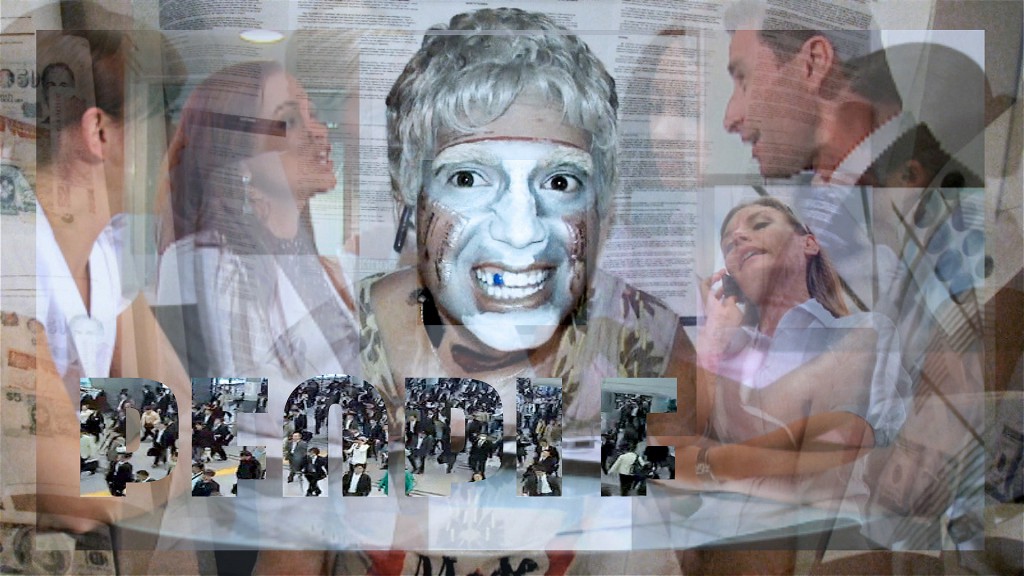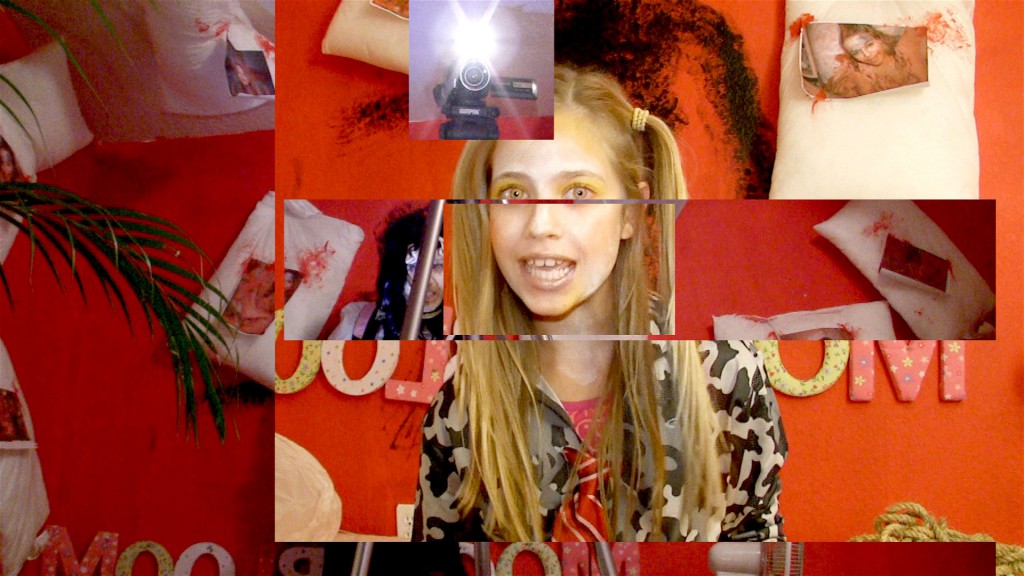RYAN TRECARTIN – ANY EVER by Nick Van Zanten
Video artist Ryan Trecartin, a veteran of Younger Than Jesus at the New Museum and the 2006 Whitney Biennial, inaugural winner of the monumental Jack Wolgin prize, RISD graduate, and 30-year old, is showing his very ambitious new piece Any Ever at PS1 this summer, marking his triumphant return to that museum for the first time since 2010. This time he has half a floor of the museum to spread out over, resulting in a much different and my opinion far better experience of his work than he has been afforded here in the past.
Any Ever is a seven-channel non-linear quasi-narrative film with each channel screening on its own, in its own room with complimentary decoration, while also being part of one of two broader divisions of the whole piece, ReSearch Wait’S and Trill-ogy Comp. This is my way of describing it, which is difficult to do. Each channel is really a stand-alone film that cannot be put in sequence with any other, but which is at the same time a montage of parts of the larger whole. It’s a film as a network or a cloud.
The films, directed, produced and acted in by Trecartin, Lizzie Fitch, his long time collaborator, and various friends and actors, are extraordinary and hard to describe. The scripts fit somewhere between gibberish, feverish internal monologue, and the neologism-filled proclamations that are popular when talking about technology or business (or nearly anything else) these days. Actors deliver the lines in artificially high-pitched voices. The sense of non sequitur is aided by hyperactive editing, not to mention unexpected and bizarre turns in the already surreal plots. Helpfully, important words often flash on screen, which gave me an odd sense of the producers being ever so slightly behind the times and out of style. This aesthetic is aided by the sets, which like the props in the viewing galleries, are completely generic. Characters are often oddly dressed and made up colorfully. They seem to enjoy committing acts of violence, but bodily fluids are always represented with hilariously fake stand-ins.
Any Ever feels a bit like a film of a bad trip. There are psychedelic colors, odd camera angles, sudden cuts, weird people doing impossible things, and it is filled with profound-sounding but actually meaningless gibberish, spoken by somewhat menacing people at a speed too fast for the viewer to catch onto. It’s a projection of the worst of our world into an insane, terrifying hallucination.
This presentation of Trecartin’s work stood out to me not only for being so much larger (seven films!), but also for taking over the galleries and completely transforming the experience in doing so. The soundtrack can only be heard on headphones, which creates an alienating barrier between the creepy ambience of the darkened rooms, which feel surreal but also utterly false, like a cheap stage set, and into which odd sounds and music are piped. All the props are brand new from Ikea and Target, connecting them to the settings in the film. This doesn’t arrest the estrangement, rather it makes the viewer feel that the place he is ill at ease in is the same bizarre world that he is seeing onscreen.
To help viewers make sense of it all, the first thing that one sees on entering is a schematic map, explaining the not only what’s where, but what the plots, characters, motifs, and general idea is. I found this useful in understanding what is actually going on in the films, rather than just experiencing the overall aesthetic that they have. But even with the notes I found it difficult to keep track because the form was so much more powerful than the content. It feels as if the aggressively jittery, hallucinatory form was designed to block out the confusing, ambiguously present content (the wall map has a comment to the effect that some viewers may never notice any sort of content, while others might – both must to be valid experiences of the piece).
I can’t say that I find the content particularly compelling. Trecartin seems to be satirizing American consumer culture (ReSearch Wait’S) and its corporate managers (Trill-ogy Comp). The form seems to be poking fun at it as well, but I can’t help thinking that the parts don’t compliment each other. Trecartin reacts to the absurdity of postcapitalism all by shouting back the gibberish that he hears, making a vague but not convincingly serious attempt to make sense of it.
One claim made by the wall map is that the two parts of the diptych are tied together into a “yin and yang” of “nihilism and boundless meaning.” Well, okay, but “boundless meaning” – meaning without any constraint and so without any definition – is meaningless. Boundless meaning is as equally devoid of real meaningfulness as no meaning (“nihilism”) is. In fact, the two are just different varieties of meaninglessness; a yin and yin defined only by their opposition to a forgotten yang. Any Ever is a diptych positing the opposition of being nothing at all and being everything at once, with the possibility of simply being something being out of the question. The same text mentions the idea of a sort of physical “synesthesia,” where reality becomes perception to the degree that one is whatever one thinks, says, or does. This phenomenon is familiar – this is what happens in movies and plays. Actors become characters and these characters are whatever the actors do, regardless of their reality. Actors often defy the laws of physics in films. Trecartin is saying that postcapitalism has reached a height of spectacle where everything is a performance and there is no real constraint of original identity to the actors – where there is no something, only everything they want to be. Only meaning, free of constraints.
On paper I completely understand what he is trying to say, and I generally agree with it. It’s great that he’s out there saying it. But in the gallery I can’t figure out if he is actually saying it. Watching the films, I find a mocking pastiche of our culture, a shrill parody that amplifies the negative until it has become something abominable and then promptly decries it. Not a satire, but an obnoxious, mocking tirade against a straw man. The form works as a satire, as do the ideas that define the content of the films, but somehow those ideas seem to slip away in the actual execution, to say nothing of the montaged plot. What is left is a just a group of insane people acting crazy in an unsound world. I guess that this is Trecartin’s point, but it’s remarkable that something so amazingly un-subtle could result from all this that went into it. Any Ever sits, intentionally, somewhere between meaning nothing and meaning everything, and so it doesn’t really mean anything. I guess that’s a fittingly inauspicious reflection of our world today, but this absence of meaning left me unsatisfied with it as art – something that may have been meant to happen.








